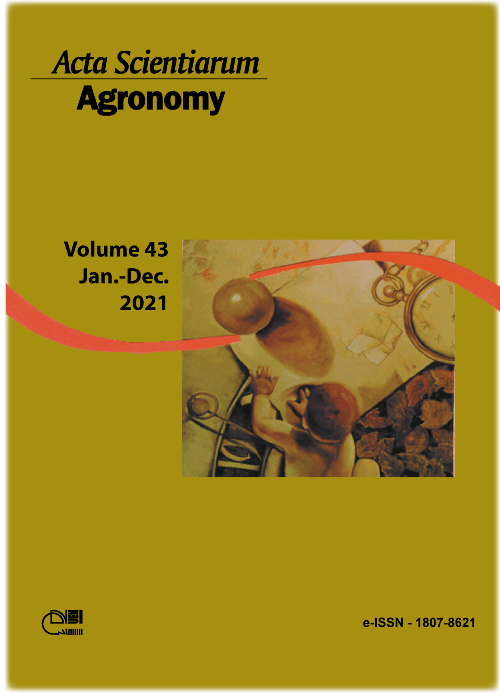Expression of genes related to the mechanism of resistance of Conyza sumatrensis to glyphosate
Abstract
The elucidation of the resistance mechanism of weeds to herbicides is important for management practices. The objective of this work was to investigate the resistance mechanism of glyphosate-resistant C. sumatrensis biotypes by determining the expression levels of the constitutive gene epsps and two ABC transport protein-coding genes designated m7 and m11 with RT-qPCR. Two biotypes of C. sumatrensis were evaluated: one resistant and one susceptible to glyphosate. The treatments consisted of the absence or application of two doses of glyphosate (1,080 and 8,640 g a.e. ha-1). Plant leaves were collected at 1 and 4 days after herbicide application. No difference was observed in epsps gene expression between the studied biotypes. The expression of the m7 and m11 genes revealed that both genes had higher relative expression in the resistant biotype with the application of glyphosate at both doses. The overexpression of the m7 and m11 genes in the resistant biotype treated with glyphosate reveals that these genes play a role in herbicide resistance. These genes may be involved in the sequestration of glyphosate into the vacuole lumen in the resistant C. sumatrensis biotype studied.
Downloads
References
Baerson, S. R., Rodrigues, D. J., Biest, N. A., Tran, M., & You, J. (2002). Investigating the mechanism of glyphosate resistance in rigid ryegrass (Lolium rigidum). Weed Science, 50(6), 721-730. DOI: 10.1614/0043-1745(2002)050[0721:itmogr]2.0.CO;2
Chachalis, D., & Travlos, I. S. (2014). Glyphosate resistant weeds in Southern Europe: current status, control strategies and future challenges. In D. Kobayashi, & E. Watanabe (Eds.), Handbook of herbicides: biological activity, classification, and health and environmental implications (p. 175-191). New York, US: Nova Science Publishers.
Dinelli, G., Marotti, I., Bonetti, A., Catizone, P., Urbano, J. M., & Barners, J. (2008). Physiological and molecular bases of glyphosate resistance in Conyza bonariensis biotypes from Spain. Weed Research, 48(3), 257-265. DOI: 10.1111/j.1365-3180.2008.00623.x
Feng, P. C., Tran, M., Chiu, T., Sammons, R. D., Heck, G. R., & Cajacob, C. A. (2004). Investigation into glyphosate-resistant horseweed (Conyza canadensis): retention, uptake, translocation, and metabolism. Weed Science, 52(4), 498-505. DOI: 10.1614/WS-03-137R
Gaines, T. A., Preston, C., Leach, J. E., Chisholm, S. T., & Shaner, D. L. (2010). Gene amplification is a mechanism for glyphosate resistance evolution. Proceedings of the National Academy of Sciences of the United States of America, 107(3), 1029-1034. DOI: 10.1073/pnas.0913433107
Ge, X., D’Avignon, D. A., Ackerman, J. J. H., & Sammons, R. D. (2010). Rapid vacuolar sequestration: the horseweed glyphosate resistance mechanism. Pest Management Science, 66(4), 345-348. DOI: 10.1002/ps.1911
Ge, X., D’Avignon, D. A., Ackerman, J. J. H., Duncan, B., Spaur, M. B., & Sammons, R. D. (2011). Glyphosate-resistant horseweed made sensitive to glyphosate: low-temperature suppression of glyphosate vacuolar sequestration revealed by 31P NMR. Pest Management Science, 67(10), 1215-1221. DOI: 10.1002/ps.2169
Ge, X., D’Avignon, D. A., Ackerman, J. J. H., Duncan, B., Spaur, M. B., & Sammons, R. D. (2014). In Vivo 31P-Nuclear Magnetic Resonance Studies of Glyphosate Uptake, Vacuolar Sequestration, and Tonoplast Pump Activity in Glyphosate-Resistant Horseweed. Plant Physiology, 166(3), 1255-1268. DOI: 10.1104/pp.114.247197
Gonzáles-Torralva, F., Rojano-Delgado, A. M., Castro, M. D. L., Mulleder, N., & De Prado, R. (2012). Two non-target site mechanisms are involved in glyphosate-resistant horseweed (Conyza canadensis L. Cronq.) biotypes. Journal of Plant Physiology, 169(17), 1673-1679. DOI: 10.1016/j.jplph.2012.06.014
Heap, I. (2020). International survey of herbicide resistant weeds. Retrieved on July 6, 2020 from http://www.weedscience.org
Klein, M., Martinoia, E., Hoffmann-Thoma, G., & Weissenbock, G. A. (2000). Membrane-potential dependent ABC-like transporter mediates the vacuolar uptake of rye flavone glucuroides: regulation of glucuronide uptake by glutathione and its conjugates. Plant Journal, 21(3), 289-304. DOI: 10.1046/j.1365-313x.2000.00684.x
Livak, K. J., & Schmittgen, T. D. (2001). Analysis of relative gene expression data using real-time quantitative PCR and the 2-(ΔΔCt) Method. Methods, 25(4), 402-408. DOI: 10.1006/meth.2001.1262
Peng, Y., Abercrombie, L. L. G., Yuan, J. S., Riggins, C. W., Sammons, R. D., Tranel, P. J., & Stewart Jr., C. N. (2010). Characterization of the horseweed (Conyza canadensis) transcriptome using GS-FLX 454 pyrosequencing and its application for expression analysis of candidate non-target herbicide resistance genes. Pest Management Science, 66(10), 1053-1062. DOI: 10.1002/ps.2004
Powles, S. B., & Yu, Q. (2010). Evolution in action: plants resistant to herbicides. Annual Review Plant Biology, 61, 317-347. DOI: 10.1146/annurev-arplant-042809-112119
Rea, P. A. (2007). Plant ATP-binding cassete transporters. Annual Review of Plant Biology, 58, 347-375. DOI: 10.1146/annurev.arplant.57.032905.105406
Santos, F. M., Vargas, L., Christoffoleti, P. J., Agostinetto, D., Martin, T. N., Ruchel, Q., & Fernando, J. A. (2014). Estádio de desenvolvimento e superfície foliar reduzem a eficiência de chlorimuron-ethyl e glyphosate em Conyza sumatrensis. Planta Daninha, 32(2), 361-375. DOI: 10.1590/S0100-83582014000200014
Shaner, D. L. (2014). Lessons learned from the history of herbicide resistance. Weed Science, 62(2), 427-431. DOI: 10.1614/WS-D-13-00109.1
Tani, E., Chachalis, D., & Travlos, I. S. (2015). A glyphosate resistance mechanism in Conyza canadensis involves synchronization of EPSPs and ABC-transporters. Plant Molecular Biology Reporter, 33(6), 1721-1730. DOI: 10.1007/s11105-015-0868-8
Verrier, P. J., Bird, D., Burla, B., Dassa, E., Forestier, C., & Geisler, M. (2008). Plant ABC proteins – a unified nomenclature and updated inventory. Trends in Plant Science, 13(4), 151-159. DOI: 10.1016/j.tplants.2008.02.001
Yuan, J. S., Tranel, P. J., & Stewart, C. N. (2007). Non-target-site herbicide resistance: a family business. Trends in Plant Science, 12(1), 6-13. DOI: 10.1016/j.tplants.2006.11.001
DECLARATION OF ORIGINALITY AND COPYRIGHTS
I Declare that current article is original and has not been submitted for publication, in part or in whole, to any other national or international journal.
The copyrights belong exclusively to the authors. Published content is licensed under Creative Commons Attribution 4.0 (CC BY 4.0) guidelines, which allows sharing (copy and distribution of the material in any medium or format) and adaptation (remix, transform, and build upon the material) for any purpose, even commercially, under the terms of attribution.




















































